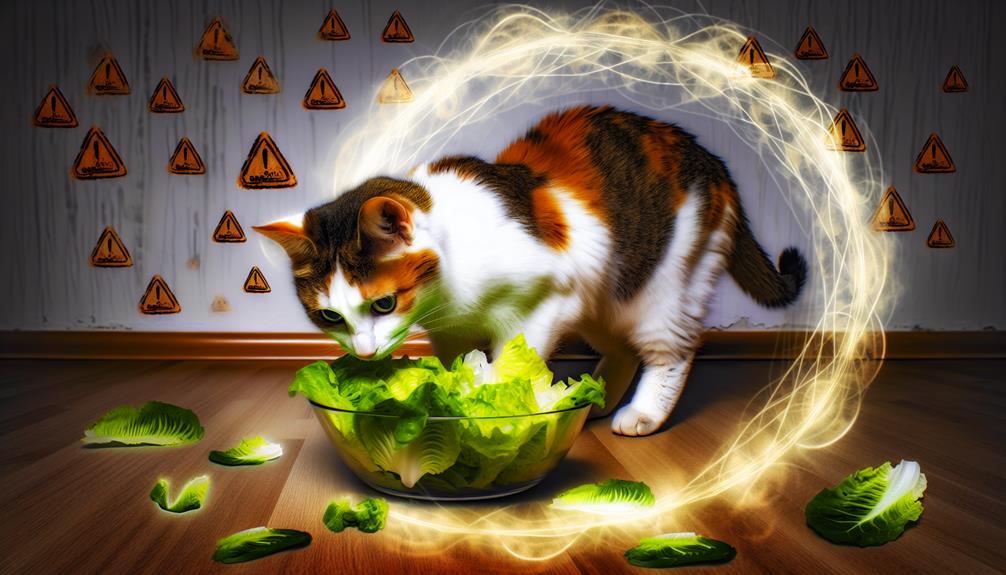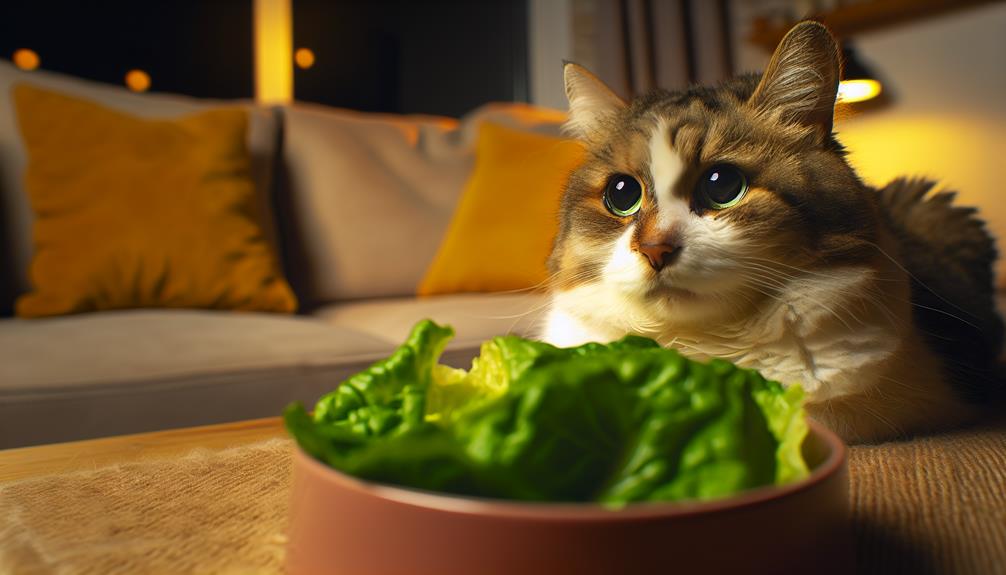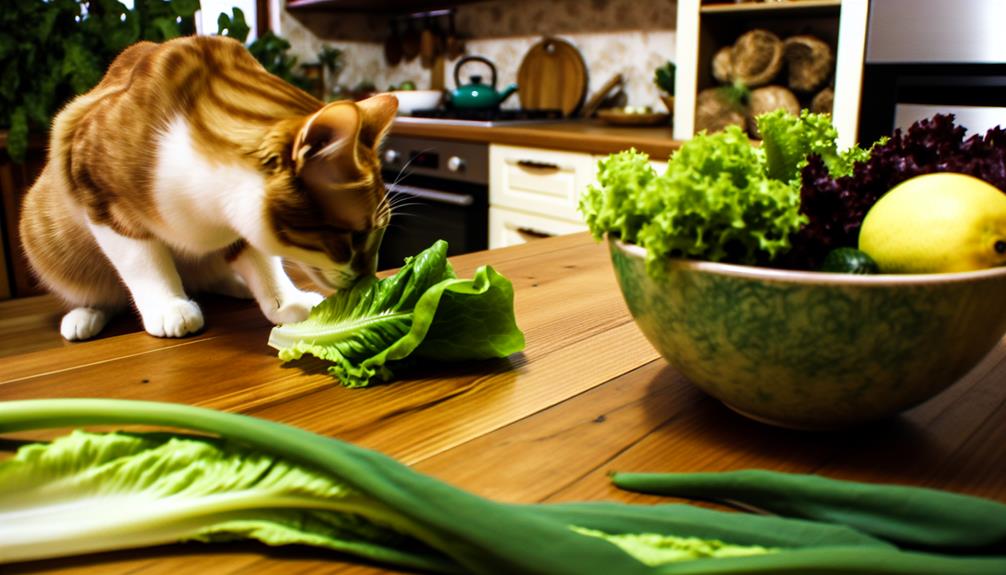It's funny you're wondering if cats can eat lettuce because I just came across this question while researching pet nutrition. You might be curious if it's safe to share your salad greens with your feline friend. Lettuce can indeed be a hydrating, low-calorie treat for cats, but there are several considerations you should keep in mind. From the type of lettuce to serving methods and potential health benefits, it's important to understand the full picture. So, how do you guarantee it's a safe addition to their diet?
Nutritional Content of Lettuce
Lettuce, a common leafy green, offers a variety of essential nutrients that can be beneficial for both humans and cats when included in their diet in moderation. To fully understand its nutritional content, it's important to take into account the different lettuce varieties. Common types include Romaine, Iceberg, Butterhead, and Leaf lettuce, each with a slightly different nutrient profile.
Romaine lettuce is particularly rich in vitamins A, C, and K, along with folate and fiber, making it a nutritious choice. Iceberg lettuce, while more popular due to its crisp texture, contains fewer nutrients but still provides hydration due to its high water content. Butterhead and Leaf lettuces offer a balance, providing moderate levels of vitamins and minerals.
When examining cat preferences, it's important to understand that cats are obligate carnivores, meaning they derive most of their essential nutrients from meat. However, small amounts of lettuce can complement their diet, particularly when it comes to hydration and fiber. Cats might prefer the softer leaves of Butterhead or Leaf lettuce over the coarser Romaine or Iceberg varieties.
Lettuce contains a range of vitamins and minerals. Vitamin A supports vision and immune function, while Vitamin C acts as an antioxidant. Vitamin K is vital for blood clotting. Folate aids in cell division and DNA synthesis. The fiber content in lettuce can aid digestive health, and the high water content helps with hydration, especially beneficial for cats who don't drink much water.
Incorporating lettuce into a cat's diet should be done cautiously and in small amounts, ensuring it complements their primary nutrient sources.
Health Benefits for Cats
When considering the health benefits of lettuce for your cat, it's essential to recognize its nutritional value, which includes crucial vitamins and minerals. Lettuce can aid in hydration and support digestion due to its high water content and fiber. However, you should adhere to safe feeding practices, offering lettuce in moderation and ensuring it's thoroughly washed to remove any pesticides.
Nutritional Value Overview
You might be surprised to learn that lettuce, while not a staple in a cat's diet, offers several health benefits due to its nutritional value. Different lettuce varieties, such as Romaine, Iceberg, and Butterhead, have varying levels of vitamins and minerals that can be beneficial for your feline friend. While cats are obligate carnivores and primarily need meat, they can still derive some advantages from the occasional piece of lettuce.
Lettuce contains essential vitamins like A, C, and K, which support your cat's overall health. Vitamin A is vital for vision and immune function, while Vitamin C acts as an antioxidant, helping to neutralize harmful free radicals. Vitamin K plays a role in blood clotting, necessary for wound healing. Moreover, lettuce is low in calories and fat, making it a non-fattening treat that won't disrupt your cat's diet.
In terms of feline preferences, some cats might be curious about the crunchy texture of lettuce. While it's not guaranteed that your cat will enjoy lettuce, offering small amounts of different lettuce varieties can help you identify any preferences they might have. Always make sure any lettuce given is washed to remove pesticides or contaminants.
Hydration and Digestion Aid
Occasionally incorporating lettuce into your cat's diet can provide hydration benefits, especially since cats often don't drink as much water as they should. Lettuce is composed of about 95% water, making it an excellent hydration source. Dehydration in cats can lead to urinary tract issues and kidney problems, so supplying additional moisture through food can be beneficial.
Lettuce also contains dietary fiber, which can aid in digestion. Fiber helps regulate bowel movements and can prevent constipation. Additionally, lettuce can stimulate the production of digestive enzymes, which are essential for breaking down food and absorbing nutrients.
Here are some specific benefits of including lettuce in your cat's diet:
- Hydration: High water content helps keep your cat hydrated.
- Digestive Aid: Fiber content can improve bowel regularity.
- Digestive Enzymes: Stimulates enzyme production for better nutrient absorption.
- Low-Calorie: Offers these benefits without contributing to weight gain.
While lettuce can be a useful supplement to your cat's diet, it shouldn't replace their primary food sources. Always monitor for any adverse reactions and consult with your vet to ascertain it's appropriate for your pet's specific health needs.
Safe Feeding Practices
Guaranteeing the safe feeding of lettuce to your cat involves several critical practices to maximize its health benefits while minimizing risks. First, always wash the lettuce thoroughly to remove pesticides and contaminants. Organic lettuce is preferable. With respect to feeding frequency, moderation is key. Offer lettuce as an occasional treat rather than a staple in their diet.
Cats are obligate carnivores, so their primary nutritional needs come from meat. Lettuce should be a supplementary snack, not a replacement for their regular food. Pay attention to your cat's preferences; some cats may enjoy lettuce, while others might show no interest. Start with small amounts to see how your cat reacts, both regarding interest and digestive tolerance.
Additionally, chop the lettuce into bite-sized pieces to prevent choking hazards. Be vigilant about any signs of gastrointestinal upset, such as vomiting or diarrhea, after introducing lettuce. If adverse reactions occur, discontinue feeding it immediately and consult your veterinarian. By adhering to these safe feeding practices, you can guarantee that your cat enjoys the potential hydration and digestion benefits of lettuce without compromising their health.
Potential Risks and Side Effects

While feeding cats lettuce might seem harmless, it's vital to understand the potential risks and side effects associated with this practice. Though lettuce itself isn't toxic to cats, it can still pose some issues. Some lettuces may harbor toxic ingredients if they've been treated with pesticides or other chemicals. Additionally, cats have sensitive gastrointestinal systems, and introducing a new food like lettuce can lead to various digestive problems.
Here are some potential risks and side effects you should consider:
- Gastrointestinal Issues: Cats might experience symptoms like diarrhea, vomiting, or upset stomach after consuming lettuce. Their digestive systems aren't designed to handle large amounts of plant matter.
- Toxic Ingredients: If the lettuce has been treated with pesticides or other chemicals, these substances could be harmful to your cat. Always confirm any vegetables you consider feeding your cat are thoroughly washed.
- Choking Hazard: Lettuce can be a choking hazard, especially if it's not chopped into small, manageable pieces. Cats may struggle to chew and swallow large or tough pieces.
- Allergic Reactions: Some cats might have allergies to certain types of lettuce or other vegetables. Signs of an allergic reaction can include itching, swelling, or difficulty breathing.
Understanding these risks helps you make informed decisions about your cat's diet. While lettuce isn't inherently dangerous, it's important to be aware of these potential issues. Monitoring your cat for any adverse reactions and consulting your veterinarian before introducing new foods is always a good practice. This way, you can guarantee your feline friend stays healthy and happy.
Safe Ways to Serve Lettuce
When serving lettuce to your cat, guarantee it's fresh and thoroughly washed to remove any pesticides or contaminants. Portion control is essential; offer small amounts to observe how your cat reacts and to avoid digestive issues. Remember, lettuce should complement their diet, not replace essential nutrients.
Freshness and Preparation
To maintain the health and well-being of your cat, it's vital to focus on the freshness and proper preparation of lettuce. Selecting the right lettuce types and employing suitable preparation methods can make all the difference in ensuring your cat enjoys a safe, nutritious experience.
First, always opt for fresh lettuce. Wilted or old leaves can harbor bacteria and reduce nutritional value. When choosing lettuce types, consider romaine, butterhead, and iceberg, as they are generally safe for feline consumption. However, romaine is often preferred due to its higher nutritional content.
Once you've selected your lettuce, proper preparation methods are important:
- Wash thoroughly: Rinse the leaves under cold water to remove any pesticides, dirt, or contaminants.
- Chop finely: Cats can have difficulty chewing large pieces, so cut the lettuce into small, manageable bits.
- Serve plain: Avoid adding any dressings, oils, or seasonings, which can be harmful to your cat.
- Inspect for freshness: Remove any damaged or discolored leaves before serving.
Portion Control
Managing portion control is essential when introducing lettuce into your cat's diet. While lettuce is generally safe, overfeeding can lead to digestive issues like diarrhea. Start with small portion sizes—about a teaspoon of finely chopped lettuce mixed into your cat's regular food. This method guarantees the lettuce is a supplement rather than a primary food source.
Pay attention to feeding frequency. Offering lettuce one to two times a week is sufficient. This occasional inclusion helps prevent any potential digestive disturbances and allows you to monitor for any adverse reactions. Be cautious and gradually increase the amount if your cat seems to tolerate it well.
Always observe your cat's behavior and stool consistency after introducing new foods. If you notice any signs of discomfort or irregular bowel movements, reduce the portion size or discontinue feeding lettuce. Remember, every cat has a unique digestive system, and what works for one may not work for another.
Confirm the lettuce is thoroughly washed to remove any pesticides or contaminants. Stick to varieties like romaine or iceberg, as they are typically well-tolerated. By carefully managing portion sizes and feeding frequency, you can safely incorporate lettuce into your cat's diet.
Signs of Allergic Reactions

Recognizing the signs of allergic reactions in cats is vital for guaranteeing their health and well-being. When you introduce new foods like lettuce to your feline friend, it's important to monitor them closely for any adverse reactions. Allergy symptoms in cats can manifest in various ways, and being able to identify these early on can prevent more severe health issues.
Common cat reactions to allergens, including food items like lettuce, might include:
- Skin Irritations: Look for excessive scratching, redness, or swelling. Cats often develop itchy spots that can lead to hair loss or sores if left untreated.
- Gastrointestinal Distress: Vomiting and diarrhea are key indicators that something in their diet isn't agreeing with their system. Persistent gastrointestinal issues warrant a prompt visit to the vet.
- Respiratory Problems: Less common but still significant, symptoms such as sneezing, coughing, or difficulty breathing can indicate an allergic reaction.
- Behavioral Changes: If your cat seems unusually lethargic, agitated, or is hiding more than usual, it might be experiencing discomfort or pain due to an allergic response.
These signs indicate that your cat's immune system is reacting negatively to a substance, in this case, potentially lettuce. If you notice any of these symptoms after introducing lettuce or any new food, it's best to remove the item from their diet immediately and consult with your veterinarian. They may recommend allergy testing to identify the specific allergen and suggest suitable alternatives to guarantee your cat's diet remains balanced and safe.
Monitoring your cat's health and being attentive to any changes in their behavior or physical condition is key to managing and preventing allergic reactions effectively.
Alternatives to Lettuce
If your cat shows signs of an allergic reaction to lettuce or any other food, it's important to explore safe alternatives that can still provide variety in their diet. Confirming a balanced diet for your feline friend involves including cat safe vegetables and leafy greens that don't provoke adverse reactions.
One excellent alternative to lettuce is spinach. Spinach is packed with essential nutrients like vitamins A, C, and K, which can contribute to your cat's overall health. However, moderation is key as spinach contains oxalates, which can lead to kidney issues if consumed in large quantities.
Another viable option is steamed broccoli. Broccoli is rich in fiber and antioxidants, making it a healthy addition to your cat's diet. Confirm it's cooked without any seasonings or additives that could be harmful.
Carrots are also a nutritious choice. They offer beta-carotene and fiber, which support eye health and digestion. It's best to serve them cooked and cut into small, manageable pieces to prevent choking hazards.
Peas are another cat safe vegetable worth considering. They provide an excellent source of vitamins A, B1, B6, C, and K, as well as protein and fiber. You can mix a small amount of cooked peas into your cat's regular food.
Lastly, consider incorporating small amounts of kale. This leafy green is loaded with vitamins and minerals but should be given sparingly due to its potential to cause stomach upset if overfed.
Always introduce new foods gradually and observe for any signs of intolerance or allergic reactions. Consulting with your veterinarian before making dietary changes confirms that your cat receives the best possible nutrition tailored to their specific needs.
Conclusion
Introducing lettuce to your cat is like offering a revitalizing, green meadow in their diet. While it can provide hydration and a touch of variety, always remember that moderation is key. Symbolically, think of lettuce as a small, occasional treat rather than a staple. Confirm it's properly prepared to avoid any health risks. As with any new food, consult your vet first to safeguard your feline's health. Your cat's well-being is your guiding star in this dietary adventure.
